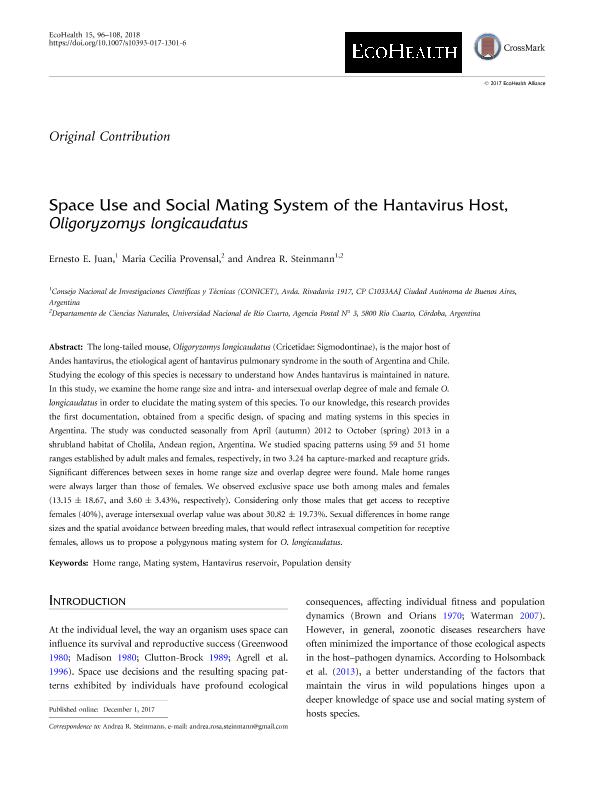Mostrar el registro sencillo del ítem
dc.contributor.author
Juan, Ernesto Ezequiel

dc.contributor.author
Provensal, María Cecilia

dc.contributor.author
Steinmann, Andrea Rosa

dc.date.available
2021-06-04T12:27:35Z
dc.date.issued
2018-03
dc.identifier.citation
Juan, Ernesto Ezequiel; Provensal, María Cecilia; Steinmann, Andrea Rosa; Space use and social mating system of the Hantavirus host, Oligoryzomys longicaudatus; Springer; Ecohealth; 15; 1; 3-2018; 96-108
dc.identifier.issn
1612-9202
dc.identifier.uri
http://hdl.handle.net/11336/133200
dc.description.abstract
The long-tailed mouse, Oligoryzomys longicaudatus (Cricetidae: Sigmodontinae), is the major host of Andes hantavirus, the etiological agent of hantavirus pulmonary syndrome in the south of Argentina and Chile. Studying the ecology of this species is necessary to understand how Andes hantavirus is maintained in nature. In this study, we examine the home range size and intra- and intersexual overlap degree of male and female O. longicaudatus in order to elucidate the mating system of this species. To our knowledge, this research provides the first documentation, obtained from a specific design, of spacing and mating systems in this species in Argentina. The study was conducted seasonally from April (autumn) 2012 to October (spring) 2013 in a shrubland habitat of Cholila, Andean region, Argentina. We studied spacing patterns using 59 and 51 home ranges established by adult males and females, respectively, in two 3.24 ha capture-marked and recapture grids. Significant differences between sexes in home range size and overlap degree were found. Male home ranges were always larger than those of females. We observed exclusive space use both among males and females (13.15 ± 18.67, and 3.60 ± 3.43%, respectively). Considering only those males that get access to receptive females (40%), average intersexual overlap value was about 30.82 ± 19.73%. Sexual differences in home range sizes and the spatial avoidance between breeding males, that would reflect intrasexual competition for receptive females, allows us to propose a polygynous mating system for O. longicaudatus.
dc.format
application/pdf
dc.language.iso
eng
dc.publisher
Springer

dc.rights
info:eu-repo/semantics/openAccess
dc.rights.uri
https://creativecommons.org/licenses/by-nc-sa/2.5/ar/
dc.subject
HANTAVIRUS RESERVOIR
dc.subject
HOME RANGE
dc.subject
MATING SYSTEM
dc.subject
POPULATION DENSITY
dc.subject.classification
Ecología

dc.subject.classification
Ciencias Biológicas

dc.subject.classification
CIENCIAS NATURALES Y EXACTAS

dc.title
Space use and social mating system of the Hantavirus host, Oligoryzomys longicaudatus
dc.type
info:eu-repo/semantics/article
dc.type
info:ar-repo/semantics/artículo
dc.type
info:eu-repo/semantics/publishedVersion
dc.date.updated
2021-06-02T12:14:49Z
dc.identifier.eissn
1612-9210
dc.journal.volume
15
dc.journal.number
1
dc.journal.pagination
96-108
dc.journal.pais
Alemania

dc.description.fil
Fil: Juan, Ernesto Ezequiel. Universidad Nacional de Río Cuarto. Facultad de Ciencias Exactas, Fisicoquímicas y Naturales. Departamento de Ciencias Naturales; Argentina. Consejo Nacional de Investigaciones Científicas y Técnicas; Argentina
dc.description.fil
Fil: Provensal, María Cecilia. Universidad Nacional de Río Cuarto. Facultad de Ciencias Exactas, Fisicoquímicas y Naturales. Departamento de Ciencias Naturales; Argentina
dc.description.fil
Fil: Steinmann, Andrea Rosa. Universidad Nacional de Río Cuarto. Facultad de Ciencias Exactas Fisicoquímicas y Naturales. Instituto de Ciencias de la Tierra, Biodiversidad y Ambiente - Consejo Nacional de Investigaciones Científicas y Técnicas. Centro Científico Tecnológico Conicet - Córdoba. Instituto de Ciencias de la Tierra, Biodiversidad y Ambiente; Argentina
dc.journal.title
Ecohealth

dc.relation.alternativeid
info:eu-repo/semantics/altIdentifier/doi/https://doi.org/10.1007/s10393-017-1301-6
dc.relation.alternativeid
info:eu-repo/semantics/altIdentifier/url/https://link.springer.com/article/10.1007/s10393-017-1301-6
Archivos asociados
